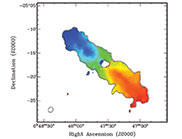A telescope is born
ASKAP is developing and proving technologies for the international Square Kilometre Array (SKA) telescope, which will start construction in Australia and South Africa in 2018. The image shows that ASKAP is now working as a fully fledged radio telescope after just a few months of commissioning.
Chief of CSIRO Astronomy and Space Science Dr Lewis Ball is leading a delegation of scientists and engineers presenting the results in Europe.
“These ASKAP results are generating great excitement in the office of the SKA Organisation in Manchester, UK, and at an SKA science meeting currently taking place in Italy, because they clearly demonstrate the revolutionary potential of CSIRO’s new phased array feed technology,” Dr Ball said.
Initial commissioning of ASKAP is being done with six of the telescope’s 36 antennas.
“ASKAP is now functioning properly as an aperture-synthesis telescope,” CSIRO’s Dr David McConnell, who leads the ASKAP Commissioning and Early Science team, ACES, said.
“We’ve never had a telescope like this before. We can see that the novel aspects of its design really do work, and that it will outperform a conventional telescope.”
Dr McConnell said when the ASKAP commissioning team saw the new image, they “practically fell off their chairs”.
The image, of a region of sky near the south celestial pole, is the equivalent of a black and white photo, but made from radio waves.
We’ve never had a telescope like this before. We can see that the novel aspects of its design really do work, and that it will outperform a conventional telescope.”
Dr David McConnell
This image covers 10 square degrees on the sky — 50 times larger than the full Moon — and was made from nine overlapping regions (‘beams’) captured simultaneously.
The quality of the image vindicates ASKAP’s two novel features: ‘phased array feeds’ — new technology developed by CSIRO — and a special axis of rotation on each antenna.
The phased array feeds act as ‘radio cameras’, allowing the telescope to see large areas of sky at once.
“This image shows that the phased array feeds are stable over the 12 hours it takes to make an observation like this,” Dr McConnell said.
“Now we can start to use the other advantages of phased array feeds, such as changing the beam size and shape for particular kinds of observations.”
As the telescope tracks radio sources, the phased array feed is kept in a fixed orientation to the sky, thanks to a special axis of rotation built into each ASKAP antenna.
“With a conventional telescope we would have expected artefacts from bright sources at the edges of each beam,” Dr McConnell said.
“With ASKAP we don’t get that, because the phased array feed is held at a constant angle to the stars.”
The dynamic range of the image was 50,000:1, which would be a good result from a mature telescope, let alone one in commissioning.
Even at this early stage, ASKAP was able to make the new image twice as fast as any comparable telescope in the Southern Hemisphere.
When completed, ASKAP will be able to survey the sky 25 times faster still, and will be the world’s premier survey telescope for centimetre-wavelength radio astronomy.
ASKAP has also made a ‘snapshot’ of a single galaxy, NGC 253, from radio waves emitted by neutral atomic hydrogen gas (HI), the fuel for making stars. This is the telescope’s first image of the HI in a galaxy.
The image captures both the intensity of the radio waves — how much HI is present in each region — and how the galaxy is rotating — which parts are approaching us, and which receding.
“If the first image was like a black-and-white photo, this one could be compared to a colour photo,” Dr McConnell said.
“What we’re looking for here is the equivalent of ‘colour balance’ — if there’s a proper balance of the radio waves at all the different frequencies used in the image.
“Happily, that balance is good. The image compares very well with one made by our established Compact Array telescope.”
Acknowledging CSIRO’s achievement with ASKAP, Australian SKA Project Director Professor Brian Boyle said “the future of radio astronomy has arrived”.
The phased array feeds (PAFs) used for these commissioning tests are of the so-called ‘first generation’ design. Procurement is now under way for even better ‘second generation’ PAFs, which tests have shown will meet their ambitious performance targets. The PAF design last year won awards for innovation from Engineers Australia and the technology is expected to find applications outside radio astronomy.
Media resources
Click image for high resolution version



